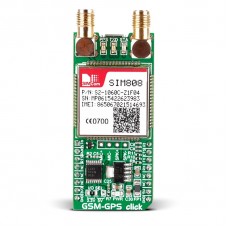GSM-GPS click
The high-performance GSM/GPRS engine works on GSM, EGSM, DSC and PCS frequencies. The GPS has a 1 second TTF (Time To First Fix) from a hot start and 30 seconds from a cold start. Tracking sensitivity is -165 dBm.
The board has two antenna connectors, one for GSM the other for GPS. The bottom side has a SIM card slot and a Micro USB connector for interfacing with a PC.
GSM-GPS click communicates with the target board MCU through mikroBUS UART interface, with additional functionality provided by STAT, PWRKEY, RTS, RS, and CTS. Beside the mikroBUS, the board has additional pins for connecting speakers and a microphone to the GSM engine.
GSM-GPS click uses the 3.3V and 5V power supply.
Specification
| Type | GPS,GSM |
| Applications | GSM and GPS, remote functionality. |
| On-board modules | SIM808, SIM card slot, antenna connectors, Micro USB slot |
| Key Features | quad-band GSM: 850, EGSM 900, DCS 1800, PCS 1900, GPS TTF: 1s cold start; 28s warm start; 30s cold start, GPS Sensitivity: -148 dBm cold start; -159 re-acquisition; -165 dBm tracking |
| Key Benefits | Automatically searches for frequency bands, SMS storage |
| Interface | UART,GPIO |
| Input Voltage | 3.3V or 5V |
| Compatibility | mikroBUS |
| Click board size | L (57.15 x 25.4 mm) |
The following are the most important features of the GPRS module:
- Quad-band 850/900/1800/1900MHz
- GPRS multi-slot class 12/10
- GPRS mobile station class B
- Compliant to GSM phase 2/2+
- Class 4 (2 W @ 850/900MHz)
- Class 1 (1 W @ 1800/1900MHz)
- Class 4 (2 W @ 850/900MHz)
- Dimensions: 24*24*2.6mm
- Weight: 3.3g
- Control via AT commands (3GPP TS 27.007, 27.005 and SIMCOM enhanced AT Commands)
- Supply voltage range 3.4 ~ 4.4V
- Low power consumption
- Operation temperature:-40℃ ~85℃
Specification for GPS
- Sensitivity
- Tracking: -165 dBm
- Cold starts : -148 dBm
- Time-To-First-Fix
- Cold starts: 32s (typ.)
- Hot starts: <1s
- Warm starts: 3s
- Accuracy
- Horizontal position : <2.5m CEP
Specifications for GPRS Data
- GPRS class 12: max. 85.6 kbps (downlink/uplink)
- PBCCH support
- Coding schemes CS 1, 2, 3, 4
- PPP-stack
- USSD
- Specifications for SMS via GSM/GPRS
- Point to point MO and MT
- SMS cell broadcast
- Text and PDU mode
Programming
This code snippet sends an SMS message with current GPS position coordinates.
1 void gsm_act_send_info()
2 {
3 char tmp[ 60 ] = { 0 };
4 char msg[ 160 ] = { 0 };
5 strcpy( tmp, "AT+CMGS=" );
6 strcat( tmp, tmp_num );
7 strcpy( msg, "LAT : " );
8 strcat( msg, latitude );
9 strcat( msg, "rnLON : " );
10 strcat( msg, longitude );
11 strcat( msg, "rnALT : " );
12 strcat( msg, altitude );
13 at_cmd( tmp );
14 at_cmd_addition( msg );
15 }
Code examples that demonstrate the usage of GSM-GPS click with MikroElektronika hardware, written for mikroC for ARM, AVR, FT90x, PIC and PIC32 are available on Libstock.
Downloads
Enter the code in the box below:








